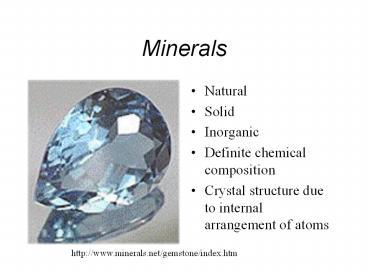Minerals - PowerPoint PPT Presentation
Title:
Minerals
Description:
Minerals Natural Solid Inorganic Definite chemical composition Crystal structure due to internal arrangement of atoms http://www.minerals.net/gemstone/index.htm – PowerPoint PPT presentation
Number of Views:255
Avg rating:3.0/5.0
Title: Minerals
1
Minerals
- Natural
- Solid
- Inorganic
- Definite chemical composition
- Crystal structure due to internal arrangement of
atoms
http//www.minerals.net/gemstone/index.htm
2
http//www.mii.org/www.mii.org
3
General Facts about Minerals
- Between 2 - 3,000 have been identified
- A few are native elements -- made of only one
element, such as sulfur, gold. copper, and
graphite (carbon) - Most are compounds, especially the silicate group
(Si, O). - Other important groups are oxides, carbonates,
and sulfides.
4
Less than a dozen are common in most rocks
- Quartz
- Feldspar (group)
- Muscovite (white mica)
- Biotite (black mica)
- Calcite
- Pyroxene
- Olivine
- Amphibole (group)
- Magnetite, limonite, and other iron oxides
- Pyrite
5
Common uses include
- Aluminum--packaging, transport, building
- Beryllium--gemstones, fluorescent lights
- Copper--electric cables, wires, switches
- Feldspar--glass and ceramics
- Iron--buildings, automobiles, magnets
- Calcite--toothpaste, construction
- http//www.mii.org/commonminerals.php
6
Minerals are identified by their key
characteristics
- hardness
- crystal shape (form)
- luster
- color
- streak
- cleavage/fracture
- density (specific gravity)
- special properties --reaction to acid
--fluorescence --salty taste
--magnetism
7
Mineral Hardness
- Ability to scratch another mineral
- Mohs scale from 1 (talc) to 10 (diamond)
- Quartz (most common mineral and most dust
particles) is 7
http//mineral.galleries.com/minerals/elements/dia
mond/diamond.htm
8
Crystal Shape (Form)
- External structure due to internal arrangement of
the atoms - Six basic groups of shapes, with about three
dozen variations
http//www.minerals.net/mineral/carbonat/aragonit/
aragoni1.htm
9
Luster
- Describes how light reflects off the surface
- Main categories are metallic and non-metallic
- Non-metallic includes dull, glassy, waxy,
pearly, and othershttp//www.minerals.net/minera
l/sulfides/pyrite/pyrite2.htm
http//www.minerals.net/mineral/sulfides/pyrite/py
rite2.htm
10
Color
- results from ability to absorb some wavelengths
and reflect others - some minerals have characteristics colors
- others vary due to chemical differences or
impurities (atoms mixed inside the main elements)
http//www.minerals.net/mineral/carbonat/calcite/i
mages/4assortd.htm
11
Streak
- Color of the powder when rubbed on a streak
plate (unglazed porcelain) - May be same as hand-specimen or different
- Some paint is based on powdered minerals
(streaks).
http//www.minerals.net/mineral/oxides/hematite/he
matit6.htm
12
Mineral cleavage/fracture
- Some minerals split along flat surfaces when
struck hard--this is called mineral cleavage - Other minerals break unevenly along rough or
curved surfaces--this is called fracture - A few minerals have both cleavage and fracture
13
Density (Specific Gravity)
- All minerals have density (mass / volume), but
some are very dense - Examples include galena, magnetite, and gold
- Specific Gravity is the density of the mineral
compared with density of water
http//www.minerals.net/mineral/elements/gold/gold
1.htm
14
Special Characteristics--the Acid Test
- Carbonates react with dilute HCl and other
acids by fizzing or bubbling (releasing CO2 gas)
15
Special Characteristics-- Fluorescence
- Some minerals will glow when placed under
short-wave or long-wave ultraviolet rays - Franklin and Ogdensburg NJ are famous for their
fluorescent minerals
http//www.sterlinghill.org/Tour20information.htm
16
Special Characteristics--Salty Taste
- DO NOT TASTE MOST MINERALS!
- Halite is the exception--it will taste salty
http//mineral.galleries.com/scripts/item.exe?LIST
MineralsHalidesHalite
17
Special Characteristics--Magnetism
- Many iron minerals will produce an invisible
magnetic force field - Lodestone was used by Vikings more than 1,000
years ago as compasses
http//www.minerals.net/mineral/oxides/magnetit/ma
gneti4.htm
18
Useful Web Sites
- www.mii.org
- www.mineral.galleries.com/minerals
- www.mineral.net
- www.usgs.gov































